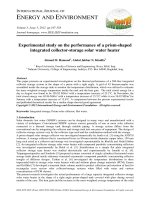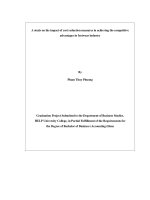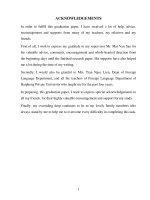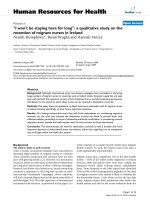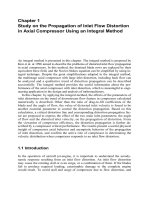Study on the determination of 10B/11B isotope ratio in water samples by isotope dilution – inductively coupled plasma mass spectrometry (ID-ICPMS)
Bạn đang xem bản rút gọn của tài liệu. Xem và tải ngay bản đầy đủ của tài liệu tại đây (327.94 KB, 9 trang )
Nuclear Science and Technology, Vol.7, No. 3 (2017), pp. 08-16
Study on the determination of 10B/11B isotope ratio in
water samples by isotope dilution – inductively coupled plasma
mass spectrometry (ID-ICPMS)
Nguyen Thi Kim Dung, Nguyen Thi Lien
Center for Analytical Chemistry, Institute for Technology of Radioactive and Rare elements (ITRRE),
48, Lang Ha, Hanoi, Vietnam
Email:
(Received 01 Octorber 2017, accepted 28 December 2017)
Abstract: The determination of 10B/11B isotope ratio and boron concentration in various water
samples using isotope dilution technique with inductively coupled plasma mass spectrometry (ICPMS) was studied. The interferences on precision and accuracy in isotopic ratio determination by ICPMS such as memory effects, dead time, spectral overlap of 12C were investigated for the selection of
optimum conditions. By the addition of certain amounts of enriched 10B into samples, the 10B/11B ratio
was determined through ICP-MS signal of 10B and 11B. The detection limit for 10B and 11B was
experimentally obtained as 0.26 µg/L and 0.92 µg/L, respectively. The ratios of 10B/11B in measured
water samples varied in the ranged between 0.1905 and 0.2484 for different matrices. This method has
been then applied for the determination of boron isotopic ratio in VVER-1000 reactor-type simulated
primary coolant water and in some environmental water samples.
Key words: ICP-MS, Boron, 10B/11B ratios, Isotope dilution, water samples, VVER-1000
I. INTRODUCTION
Boron (B) is a light element that has two
natural isotopes 10B and 11B with 19.9 % and
80.1 % atomic abundances, respectively. Boron
exists in solution in two forms-viz, trigonal
boric acid B(OH)3 and tetrahedral borate anion
B(OH)4-. These two forms equilibrated in
solution, and their relative proportions depend
upon the pH of the solution, as given below:
B(OH)3 + H2O = B(OH)4- + H+
(1)
At high pH values (pH > 11), B(OH)4
dominates, while B(OH)3 is the dominant
form at pH < 7. An equilibrium isotope
fractionation can, therefore, only be expected
if the aquatic system has a pH between 7 and
11. Boron is stable in aqueous solutions as an
oxo-anion and is not affected by oxidationreduction reactions [1].
Trigonal B(OH)3 is predominant in
acidic media whereas the tetrahedral anionic
form is mainly in basic solution. B(OH)3 can
be more enriched in 11B, whereas B(OH)4- is
more enriched in 10B as given below in
exchange fraction.
10
B(OH)3 + 11B(OH)4- = 11B(OH)3 + 10B(OH)4-(2)
This could be observed in the adsorption
of seawater by clay due to the differences in
the vibrational frequencies of the two boron
isotopes and the molecular coordination
between boron species in different phases [2].
It can thus be predicted that natural water from
different matrices might vary the 10B/11B ratio.
Boric acid is an important compound of
boron, which has been widely using in nuclear
industry as strong thermal neutron absorbers
[3]. The important role of boric acid in nuclear
power plant was to control nuclear fission rate
and thus to influence with the power
©2017 Vietnam Atomic Energy Society and Vietnam Atomic Energy Institute
NGUYEN THI KIM DUNG, NGUYEN THI LIEN
generation [4].The investigated works on
pressurized water reactors showed that
enriched 10B in coolant gave very strong
absorption ability that absorption cross section
of thermal neutron was five fold to natural
boron abundance. During operation of nuclear
reactor, the concentration of 10B in coolant
water should be reduced commensurably
which required the regular determination of
isotopic composition and concentration of
boron. The determination of 10B/11B ratio could
thus support the estimation of the B amount
being absorbed by neutrons, and supply boric
acid in time.
treatment. The introduction of isotope dilution
technique into this method resulted in the most
precise approach in quantitative determinations
[18].
ICP-MS combined with isotope dilution
technique had been used for the determination
of boron in high purity quartz [19], iron and
steel [20-22], body fluids [23]. The isotope
dilution technique was not interfered with the
recovery of analyte and with the signal drift of
measurement on ICP-MS. However, there were
difficulties with the determination of trace
boron in different sample matrices by ICP-MS
due to the high memory effect, dead time effect
and spectral overlap of 12C (if there was) to
11
B. Memory effect could be minimized by the
introduction of mannitol and ammonia [24]
together with the sample just before the
nebulizer [25], or by injection of ammonia gas
into the spray chamber during the analysis [26,
27]. In our study, mannitol in nitric acid
solution was applied for the enhancement of
precision and accuracy measurement.
Nowadays, the advanced spectroscopic
techniques such as: thermal ionization mass
spectrometry (TIMS), secondary ion mass
spectrometry (SIMS) and inductively coupled
plasma source mass spectrometry (ICP-MS)
were widely applied for the determination of
10
B/11B isotope ratio. TIMS provided a high
level of accuracy and precision for the
determination of B isotopic composition [5-7].
However, TIMS required a purification steps
[6] that caused the time consumption [8]. SIMS
method could supply an advantage to analyse
boron at relatively low concentration in a solid
sample [9-11] but the volatile phase of boron
caused the difficulty to get the high accuracy of
analysis. The experiences from nuclear power
plant utilities showed that ICP-MS was
preferable to analyse the 10B concentration in
coolant system [12].
II. EXPERIMENTAL
A. Instruments
An ICP-MS instrument (7500a, Agilent)
with quadrupole mass spectrometer was used
in this study. The operating conditions of ICPMS were optimized by using mass standard
solution to obtain the ratios of oxide ions
(Ce+O/Ce) and doubly positive charged ions
(Ce2+/Ce+) at the values of about 1.0 and 2.5 %,
respectively. The operating conditions of ICPMS system and the data acquisition parameters
were summarized in Table I.
ICP-MS seemed to be a useful method to
determine boron isotope ratios and boron
concentration in a variety of matrices [13-17]
though it required the sufficient sample
Table I. Operating parameters of ICP-MS system
Parameters
Value
Parameters
Value
RF power
1240W
Pressure for analysis
3.10-4-2.10-3 Pa
Sample uptake
90 s
Coolant flow
2.2 l.min-1
9
STUDY ON THE DETERMINATION OF 10B/11B ISOTOPE RATIO IN WATER SAMPLES BY …
Sample flow
0.1 ml.min-1
Coolant temp
Sample depth
6.4mm
Data Acquisition conditions
-1
2oC
Plasma gas flow
15 l.min
Peak pattern
Full quant (3)
Carrier gas flow
1.2 l.min-1
Integrations time
0.1s
ppb with average values of 200 – 250 ppb.
Potassium / lithium ratio changed during the
cycles from 10 - 100 ppm with average values
in the range of 10-30 ppm.
B. Reagents and standard solutions
Standard solution of isotope enriched 10B
and that of 11B (10mg/l) supplied by Inorganic
Venture Company (USA). Standard stock
solution of B 1000 mg/l was prepared in 0.3 M
HNO3 by dissolution of a certain amount of
99.99% H3BO3 (Merck, Germany). Other
chemicals (HNO3, mannitol, ammonia) were at
analytical grade. All solutions were prepared in
ultrapure water (Mili-Q with resistivity
18MΩcm-1) and further diluted. Argon gas
(Messer) with 99,999% purity was used.
In present study, a synthesized sample
with the composition of 1400 mg/l B as
H3BO3, 24 mg/l KOH and 5mg/l NH3 to adjust
pH25 in the range 7.0-7.2 was prepared in
ultrapure water. This stock sample was then
diluted proportionally into 10ml volumetric
flask, where the enriched 10B was spiked.
These spiked sample solutions were measured
using ICP-MS system under the identical
condition. The signals (cps) at m/z =10 and
m/z=11 for 10B and 11B were recorded,
respectively.
C. Sample preparation
Water samples (mineral water, drinking
water, pure water) could be stored in
polyethylene bottles at 8oC, if necessary. Each
portion of 5 to 7 ml of sample was transferred
into five of 10 ml plastic volumetric flasks. 0.5
ml of 10% HNO3, 0.5 ml of 2.5% D-mannitol
solution and different amount of enriched 10B
standard solution was added then filled up with
ultrapure water. A blank sample was prepared
for background correction.
D. Isotope dilution analysis
The isotope dilution (ID) technique is
based on the addition of a known pure isotope
to a sample containing the same element with
variously isotopic abundance. The isotopic
ratio between the added and the originally
containing isotope in the mixed solution was
measured on ICP-MS after the equilibration of
the spike isotope with the analyte in the sample
reached.
Water sample of simulated coolant water
in the primary loop of a VVER 1000 unit was
prepared according to the reference [28] from
boric acid and potassium hydroxide. Boron
concentration was taken in the range of 10002500 mg/l (simulated the operating cycle
state). Total alkalinity was given by the
concentration of potassium, lithium and
sodium to equivalent potassium to be allowed
as 20 ppm at maximum value. Lithium
concentration varied during the operation
cycles from 50 to 600 ppb with average values
of 300-350 ppb, that of sodium from 30 to 350
By adding other amounts of 10B into
samples, 10B and 11B signals on ICP-MS
system were obtained and the correlation of 10B
and 11B signals toward the added amount of
enriched 10B would show by an equation Y = A
+ BX. The 10B/11B isotope ratio is calculated
by the following formula:
(3)
10
NGUYEN THI KIM DUNG, NGUYEN THI LIEN
Where: A10 denotes the coefficient of the
plotted curve on the basic of dependency
between 10B signal and 10B spike amounts;
The dead time effect was automatically
corrected with the instrument software. Besides
the software correction, counting signals of the
two isotopes were limited to between 100,000
and 2000000 to minimize the uncertainty from
the dead time effect.
A11 denotes the coefficient of the plotted
curve on the basic of dependency between 11B
signal and 10B spike amounts;
C. Effect of spectral 12C onto 11B and 10B
III. RESULTS AND DISCUSSIONS
The spectral interference of 12C signals
at 10B and 11B atomic masses was evaluated by
the measurement of different concentrations of
mannitol in the absence of boron. The results
were shown in Fig1. It was seen that the signal
of 10B was not influenced with those of C while
signal of 11B enhanced with the increase of
mannitol concentration. However, the 11B
signal was slightly increased in the range
between 0 and 0.1% mannitol, and the
interference would be controlled at the fixed
mannitol concentration within this range.
Furthermore, the addition of mannitol could
reduce the memory effect [25] that would help
the high recovery of each measurement and
0.05% mannitol was thus used for sample
analysis in this work.
A. Matrix effect
Matrix effects in ICP-MS are generally
dependent on the mass due to the space charge
effect [17]. Since boron is a light element, the
matrix effect of any heavier element can be
severe. Furthermore, the two isotopes 10B and
11
B have different matrix effects, which could
cause the deviation in the measured isotope
ratios. On the other hand, the concentration of
alkali and alkaline earth elements in
environmental water might contribute to the
matrix effect on the direct boron determination
using ICP-MS but it would be negligible with
the use of isotope dilution technique.
B. Memory effect and dead time effect
Boron is known to be one of the
elements that are difficult to determine using
ICP-MS due to a significant memory effect.
Al-Ammar et al. [25, 26] reported that a
primary source of the memory effect was the
volatilization of boric acid droplets in the spray
chamber. For the elimination of the memory
effect, Vanderpool et al. [27] adjusted pH of
sample solution to about 10 by addition of
ammonium hydroxide solution or introducing a
small amount of ammonia gas in the nebulizer
gas flow [25, 26]. Sun et al.[24] added
mannitol to the sample solutions to prevent B
from binding to the spray chamber walls. In
our work, 0.05% mannitol in 0.5% HNO3 was
added in sample solution and a dilute ammonia
solution
used
for
rinsing
between
measurements.
Fig.1 The dependence of apparent signal (counts/s)
of 10B and 11B on mannitol concentration
D. Limit of detection, limit of quantitation
The limit of detection (LOD) of ICP-MS
measurement for each isotope mainly
depended upon the numbers of factors such as
instrumental sensitivity, spectral interferences,
memory effect, cleanliness of digestion vessels
and blank level of analytical reagents. It is
11
STUDY ON THE DETERMINATION OF 10B/11B ISOTOPE RATIO IN WATER SAMPLES BY …
possible to define the lowest concentrations
that can be reliably detected and quantified.
The LOD and LOQ of 10B and those of 11B are
determined by the calculation based on the
following formula [29]:
LOD
3S .C STD
I std I blank
LOQ
linear regression equation (Y = 0.9936X 0.0006).
10 S .CSTD (4)
I std I blank
Where: CSTD is concentration (µg/L) and ISTD is
average intensity of the standard sample (cps);
S is standard deviation and Iblank is raw
average intensity of the blank (cps);
Table II. Limit of detection and limit of quantitation
Isotope
10
11
B
B
Concentration
(µg/L)
100
100
LOD
(µg/L)
0.26
0.92
Fig.2. Calibration curve of B isotopic ratio
LOQ
(µg/L)
0.86
3.04
It is thus posible to correct the MIR
10/11 values of unknown samples using ID
technique on the basic of isotopic ratios of
spiked 10B on 11B samples.
Although B was a light element that was
difficult to determine by ICP-MS but the
results showed that this modern technique was
capable of detection and quantification of
boron at a trace amount.
F. Selection of 10B spike added amount
Water sample containing 100µg/L B was
prepared in a plastic flask. Two sets of 10B
spikes were then added into different flasks.
Set I consisted of the following concentration:
2, 5,10, 15, 20 µg/L 10B and the set II would
contain respective 50, 100, 150, 200 µg/L 10B.
All sample solutions were measured on ICPMS under the identical condition. The below
figures showed the correlation of 10B and 11B
signals toward the added amount of 10B spikes.
Within a narrow range of added amount of 10B
spikes in set I (Fig.3), the isotope ratio 10B/11B
(R) was calculated by formula (3) to be 0.2271
with RSD = 0.35%, and the recovery of boron
concentration was estimated as 100.33%.
E. Isotopic calibration curve
The experimental value of 10B/11B ratio
measured on ICP-MS very much depended on
instrument parameters such as plasma power,
sample depth, fractionation of a light element,
ect... A correction factor should be included in
the calculation mentioned in formula (3),
which could be obtained from the isotopic
calibration curve for the improvement of the
accuracy.
The isotopic calibration curve (Fig.2)
was plotted by the Measured Isotopic Ratio MIR10/11 values (the ratio of measured signals
from boron solutions, in which 10B/11B ratio
was changed while keeping constant total
concentration) vs. MR10/11 values (Mass
Ratio of corresponding composition between
10
B and 11B in solutions). The result showed
that high linearity correlation (R2=1) from the
The isotopic ratio 10B/11B (R) was
calculated by formula (3) to be 0.2191 with
RSD = 0.27% and the recovery of boron
concentration was 106.32% for the added
amount 10B spikes in set II (Fig.4). These
results showed that the isotopic ratio between
added amount 10B spikes in set I (range of 220 µg/L) and that in set II (range of 5012
NGUYEN THI KIM DUNG, NGUYEN THI LIEN
200µg/L) did not much change and the
difference was within 1,3% error though the
concentration of set II spike was much higher
than that of set I. Therefore, the 10B/11B
isotopic ratio value in the range of studied
samples seemed not be affected by the added
amount of 10B spike. However, the enriched
10
B spike was tested for each sample batch and
this added amount was often fixed within the
researched sample series.
360000
Signal of B (cps)
280000
240000
200000
0
733000
11
10
Signal of B (cps)
734000
320000
Y=A+B*X
Parameter
Value Error
------------------------------------A
165947.96
547.22
B
8914.51
44.56
Y=A+B*X
Parameter
Value Error
------------------------------------A
730775.46
10.59
B
172.59
0.86
732000
731000
5
10
15
20
10
Adding amount of B (µg/L)
0
5
10
15
20
10
Adding amount of B (µg/L)
Fig.3 Correlation of 10B and 11B signals to added amount of 10B spikes (Set I: 2-20µg/L)
800000
11
Signal of B (cps)
B (cps)
1200000
10
1600000
Signal of
2000000
Y=A+B*X
Parameter
Value Error
-----------------------------------A
165908.75
15957.68
B
8688.33
116.538
760000
752000
Y=A+B*X
Parameter
Value Error
---------------------------------------A
753455.1
702.09
B
163.3
5.12
744000
736000
50
100
150
200
10
Adding amount of B (µg/L)
50
100
150
200
10
Adding amount of B (µg/L)
Fig.4 Correlation of 10B and 11B signals to added amount of 10B spikes (Set II: 50-200µg/L)
RSD = 0.29%. It was well agreed with the
value of naturally isotopic boron compositions
in boric acid (Merck Reagent, FR Germany
made), which was confirmed within 19.9 to
22 % for natural boric acid (NBA) type by
French researchers [12]. In order to learn
further about boron isotopic ratio, several
natural water samples were analyzed using this
ID technique.
G. Analysis of VVER 1000 - type simulated
primary coolant water sample
The measurement of simulated primary
coolant water samples was carried out under
the identical conditions. The amount of 10B
was added in the range between 5 and 20 µg/L.
The correlation between 10B signal and 11B
signal with spiked amount of 10B was showed
in Fig.5.
The isotope ratio 10B/11B (R) was
calculated by formula (3) to be 0.2164 with
13
STUDY ON THE DETERMINATION OF 10B/11B ISOTOPE RATIO IN WATER SAMPLES BY …
158000
Y=A+B*X
Parameter
Value Error
--------------------------------------A
149574.68
269.93
B
490.45
19.71
154000
152000
5
705000
700000
11
156000
B (cps)
710000
Signal of
Signal of
10
B (cps)
160000
Y=A+B*X
Parameter
Value Error
---------------------------------A
691083.56
362.46
B
873.6418
26.47
695000
10
15 10
20
Adding amount of B (µg/L)
5
10
15
10
20
Adding amount of B (µg/L)
Fig 5. Correlation of 10B and 11B signal to 10B spikes in simulated sample
that of European boron isotopic ratio [12]. This
difference could reflect the original source of
water and it was also found to vary toward the
region [30]. However, as an aspect of
environmental water for human life, according
to provisional guideline values for drinking
water of WHO[31] (0.5 mg/L) and that of
QCVN 01-2009 (Ministry of Health) [32] (0.3
mg/L), boron concentration should be lower
than these limits in water for drinking usage.
Moreover, boron concentration in human intake
must not exceed 1mg/kg body weight/day [31],
it should be safe for the consumption of
approximately 2 litres water per day (about
0.064 mg boron intake per person), due to a
very small fraction of the total amount of boron
intake by drinking except for food.
H. Analysis of environmental water samples
The environmental water samples
(drinking water, mineral water,..) were collected
and stored as above described procedure. The
different amount of enriched 10B isotope was
spiked. The isotopic ratio between 10B and 11B
was calculated by formula (3). From that ratio
10
B and 11B concentration in samples was
determined and corrected by isotopic calibration.
The results of 10B/11B were showed in table IV.
The 10B/11B isotopic ratio of the different
water matrices seemed various (Table IV). The
values obtained from spring water and bottled
mineral water were similar to the natural boron
abundance but these from tap water and from
IAEA artificial mineral water gave higher than
Table IV. Analysis of environmental water samples
10
Sample name
10
B
conc.(µg/L)
B/11B
11
B conc.
(µg/L)
Boron
conc.(µg/L)
Mineral water (IAEA-V1)
0.2484±0.001
248.40±1.19
1000.0±4.07
1248.4±4.24
Spring Water (PacBo-CaoBang, VN)
0.1905±0.007
4.40±0.16
22.88±0.83
27.28±0.85
Bottled Mineral water (VN)
0.2040±0.009
2.69±0.11
13.18±0.58
15.87±0.59
Tap water – HN-1
0.2426±0.008
6.40±0.21
26.14±0.85
32.54±0.88
Tap water - HN-2
0.2530±0.005
6.60±0.12
25.86±0.51
32.46±0.52
Tap water - BN
0.2309 ±0.002
29.64±1.68
127.21±7.23
156.85±7.42
Mineral water BON-AQUA (Czech)
0.2045±0.003
41.34±0.62
200.01±2.93
115.20±2.99
Mineral water CRISTALINE (France)
0.2078±0.003
29.68±0.43
142.86±2.07
241.34±2.11
Mineral water ASAHI-Japan
0.2202±0.003
31.45±0.42
142.85±1.91
172.54±1.96
Mineral water TSUNAN- Japan
0.2252±0.003
29.25±0.39
129.88±1.73
174.3±1.77
14
NGUYEN THI KIM DUNG, NGUYEN THI LIEN
[5] Y. K. Xiao, E. S. Beary, and J. D. Fassett, “An
improved method for high-precision isotopic
measurement of boron by TIMS”, Int. J. Mass
Spectrom. Ion Proc. 85, 203-213, 1988.
II. CONCLUSIONS
The determination of 10B/11B ratio in
water samples by ID-ICP-MS was studied and
the analytical procedure would thus be
established for the application in boron isotopic
ratio investigation on pressurized water reactor
(VVER1000 – type) simulated primary coolant
samples and in environmental water samples.
The 10B/11B ratio in measured water samples
ranged from 0.1905 to 0.2484, which were
very much dependent on the substance
matrices. In addition to the conclusion, boron
concentration in studied samples of drinking
water varied from 15.87 to 32.54 µg/L, with an
average value of 27.04 µg/L. The obtained
values were below WHO-recommended limit
of 0.5 mg/L that would be safe for drinking
usage. The studied method was further
expanded for the application in analysis of
trace boron content in different sample matrix
such as food, geology, biology.
[6] Y.K.Xiao, “Rapid and high precision determination of boron isotopic ratio in boron
carbide using MS by the thermal ionization of
the di-cesium metaborate cation”, Chin. Sci.
Bull. 36, 173-175, 1991.
[7]
R. L. Bassett, “A critical evaluation of the
available measurements for the stable isotope
of B”, Appl. Geochem. 5, 541-554, 1990.
[8] P. E. Johnson, “Methodology for stable isotope
analysis in biological materials” [a review], J.
Micronutr. Anal. 6, 59-83, 1989.
[9] L.E.Jones & P.A.Thrower, “The influence of
structure on substitutional doping SIMS
analysis of Bdoped pyrolytic graphites”,
Carbon 28, 239-241, 1990.
[10] P. K. Chu, R. J. Bleiler, and J. M. Metz,
“Determination of sub-parts per billion boron
contamination in N+ Czochralski silicon
substrates by SIMS”, J. Electrochem. Soc. 141,
3453-3456, 1994.
[11] R. A. Lukaszew, J. G. Marrero, R. F. Cretella,
and C. J. Noutary, “Spark source mass
spectrometry applied to the determination of
the isotopic composition of samples containing
lithium, boron or iron”, Analyst 115, 915-917,
1990.
ACKNOWLEDGEMENT
This work has been financially supported
by Ministry of Science and Technology under
frame
work
of
a
project
encoded
ĐTCB.12/15/VCNXH (2015-2016).
[12] Fabien Jouvet, Sylvie Roux, Stephanie
Carabasse, Didier Felgines, “Boron analysises
in the reactor coolant system of French PWR
by acid – base titration ([B]) and ICP-MS (10B
atomic %); key to NPP safety”, EDF (France),
No.156, 2012.
REFERENCES
[1] Palmer M. R. and G. H. Swihart, “Boron isotope
geochemistry: An overview”, In: Boron,
Mineralogy, Petrology and Geochemistry (Ed.
E.S. Grew, L.M. Anovitz) Rev. Mineral., 33,
845-862, 1996.
[13] He M., Jin Z., Luo C., Deng L., Xiao J., &
Zhang F., “Determination of boron isotope
ratios in tooth enamel by inductively coupled
plasma mass spectrometry (ICP-MS) after
matrix
separation
by
ion
exchange
chromatography”, J. of the Brazilian Chemical
Society, 26(5), 949-954, 2015.
[2] Ram N. Sah and Patrick H. Brown, “Isotope
Ratio Determination in Boron AnalysisReview”, Biol. Trace Elements Analysis, 66,
39-53, 1998.
[14] Guerrot C., Millot R., Robert M., & Negrel P.,
“Accurate and High-Precision Determintaion
of Boron Isotopic Ratios at low Concentration
by MC-ICP-MS (Neptune)”, Geostandards
and Geoanalytical Research, 35(2), 275-284,
2011.
[3] Zhang L, Zhang WJ, Xu J. et al, “Preparation of
boric-10 acid applied in nuclear industry”, Trans
Tianjin Univ 21, 172–177, 2015.
[4] Odar S., “Fundamental aspects of water
chemistry in the primary system of PWRs”, In:
Water chemistry seminar, Suzhou, China, 2007.
15
STUDY ON THE DETERMINATION OF 10B/11B ISOTOPE RATIO IN WATER SAMPLES BY …
[15] Manoravi P., Joseph M., Sivakumar N., &
Balasubramanian R., “Determination of
isotopic ratio of boron in boric acid using laser
mass spectrometry”, Anal.Sci., 21(12), 14531455, 2005.
[24] Sun D. H., Ma R. L., McLeod C.W., Wang X.
R., & Cox A. G., “Determination of boron in
serum, plasma and urine by inductively
coupled plasma mass spectrometry (ICP-MS).
Use of mannitol-ammonia as diluent and for
eliminating memory effect”, Journal of
Analytical Atomic Spectrometry, 15(3), 257261, 2000.
[16] Hou K., Li Y., Xiao Y., Liu F., & Tian Y.
(2010)“In situ boron isotope measurements of
natural geological materials by LA-MC-ICPMS”, Chinese Science Bulletin, 55(29), 33053311.
[25] Al-Ammar A., Gupta R. K., & Barnes R.M.,
“Elimination of boron memory effect in
inductively coupled plasma-mass spectrometry
by addition of ammonia”, Spectrochimica
Acta Part B: Atomic Spectroscopy, 54(7),
1077-1084, 1999.
[17] Smith F. G., Wiederin D. R., Houk R. S., Egan
C. B., & Serfass R. E., “Measurement of boron
concentration and isotope ratios in biological
samples by ICP-MS with direct injection
nebulization”, Anal. Chim. Acta , 248(1), 229234, 1991.
[26]
[18] Evans S., Krähenbühl U., “Boron analysis in
biological
material:microwave
digestion
procedure &determination by different
methods”, Fresenius' J. Anal Chem, 349(6),
454-459, 1994.
Al-Ammar A. S., Gupta R. K., & Barnes
R.M., “Elimination of boron memory effect in
inductively coupled plasma-mass spectrometry
by ammonia gas injection into the spray
chamber during analysis”, Spectrochimica
Acta Part B: Atomic Spectroscopy, 55(6), 629635, 2000.
[27] Vanderpool R. A., Hoff D., & Johnson P.E.,
“Use of inductively coupled plasma-mass
spectrometry in boron-10 stable isotope
experiments
with
plants,
rats,
and
humans”, Environmental
health
perspectives, 102 (Suppl. 7), 13, 1994.
[19] Karunasagar D., Dash K., Chandrasekaran K.,
& Arunachalam J., “ICP-MS determination of
trace amounts of boron in high-purity
quartz”, Atom.
Spect.-Norwalk
Connecticut, 21(6), 216-219, 2000.
[20] Coedo A. G., Dorado T., Fernandez B. J., &
Alguacil F.J. “Isotope dilution analysis for
flow injection ICP-MS determination of
microgram per gram levels of boron in iron
and
steel
after
matrix
removal”, AnalyticalChemistry, 68(6),991-996,
1996.
[28] J. Kysela, M. Zmitko, V.A.Yurmanov, V.F.
Tiapkov, “Primary coolant chemistry in VVER
units”, Nuclear Engineering & Design 160,
185-192, 1996.
[21] Park C.J., “Determination of Boron Steel by
Isotope-Dilution Inductively Coupled Plasma
Mass
Spectrometry
after
Matrix
Separation”, Bull.
of
the
Korean
Chem.Soc., 23(11),1541-1544, 2002.
[22] Fujimoto K., Shimura M., & Satoh S.,
“Determination of trace amounts of antimony
and boron in high-purity iron and steel by
isotope dilution -inductively coupled plasma
mass
spectrometry”,
Materials
Transactions, 43(2), 101-104, 2002.
[29]
Analytical detection limit guidance &
Laboratory Guide for Determining Method
Detection Limits, Wiscosin Wisconsin
Department of Natural Resources Laboratory
Certification Program, (code PUBL-TS-05696), 1996.
[30]
A. Vengosh, Y.Kolodny, A.J Spivack,
“Ground-water polution determined by borron
isotope systematics”, Application of isotope
techniques to investigate groundwater
pollution 17, 1998.
[31] WHO Guidelines for drinking-water quality,
2nd Edi. Addendum to vol 2. Health criteria and
other supporting information. Boron
in
Drinking water, World Health Organization,
Geneva, 1998.
[23] Bellato A. C. S., Giné M. F., & Menegário A.
A., “Determination of B in body fluids by
isotope dilution ICP-MS with direct injection
nebulization”, Microchem.J., 77(2), 119-122,
2004.
[32] QCVN 01:2009/BYT, National technical
regul-ation on drinking water quality, Ministry
of Health.
16
